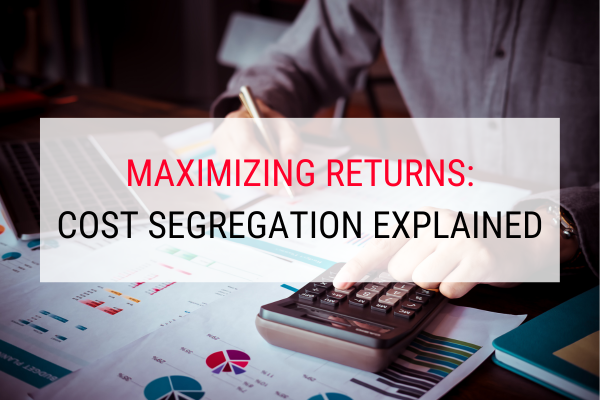December 18, 2023, by Christie Slatcher
Investing in rental properties can be a rewarding venture, providing a consistent stream of income and long-term financial growth. However, to truly make the most of your rental property investments, it’s crucial to explore every avenue that can increase your returns.
One powerful strategy that property owners often overlook is cost segregation.
In this blog, we will delve deep into the world of cost segregation, unraveling its complexities and demonstrating how it can be your secret weapon for financial success in your real estate investment journey.
What is Cost Segregation?
Cost segregation is a tax planning strategy that identifies and reclassifies personal property assets to accelerate depreciation deductions, providing property owners with substantial tax benefits. This approach categorizes assets within a property into shorter depreciation periods, allowing owners and investors to write off a larger portion of the property’s cost early on in ownership.
Standard Depreciation
Traditionally, property owners have relied on the standard depreciation method to recover the cost of their assets over time. This approach spreads the depreciation expense evenly across the useful life of the property, which is typically 27.5 years for residential properties and 39 years for commercial properties.
While this provides a steady and predictable deduction, it may not be the most advantageous for those seeking to maximize returns in the short term.
Accelerated Depreciation
It is important to note that not all components of a property have the same lifespan. Cost segregation aims to identify and classify these components into shorter depreciation periods. By doing so, you can front-load your deductions, increasing the depreciation expense you can claim in the early years of ownership. This results in immediate tax savings, more cash in your pocket, and a significantly enhanced return on your investment.
The accelerated depreciation approach aligns with the actual economic life of assets, providing a more accurate reflection of their wear and tear. Commonly, assets are classified into categories with shorter recovery periods, such as 5, 7, and 15 years:
- 5-Year Property: This category includes assets like carpets, appliances, and certain specialized lighting systems.
- 7-Year Property: Items like office furniture, fixtures, and certain building components fall into the 7-year category.
- 15-Year Property: Land improvements, such as landscaping and some exterior improvements, often fall into the 15-year category.
Since 2018, taxpayers have been fortunate enough to benefit from 100% bonus depreciation through cost segregation. However, the benefits are decreasing by 20% each year beginning with tax year 2023 and will end in tax year 2026. In order to profit from this strategy, you need to take action soon.
Who Might Consider Cost Segregation?
Asset Income Investors: For individuals looking to generate regular income from their real estate investments, cost segregation provides a proactive method to improving financial performance without the need to sell or divest assets. This tax method gives immediate tax benefits by speeding depreciation through the identification of shorter-lived assets, enhancing cash flow and overall profitability.
New Property Construction or Renovations: If you’ve recently constructed a new building or undertaken significant renovations, you can still take advantage of this strategy. Cost segregation is not just limited to existing properties–in fact, it’s often more effective for new construction since the component details can be precisely documented from the beginning.
Real Estate Professionals: Professionals in the real estate industry, such as brokers, property managers, and developers, can elevate their services by incorporating cost segregation as a strategic financial tool. Its adoption not only improves their real estate portfolio but also adds significant value for their clients.
Long-Term Property Holders: While cost segregation provides immediate tax benefits, its advantages extend to long-term property holders as well. By optimizing cash flow early on, property owners can reinvest in their assets, pursue additional opportunities, or strengthen their financial position over the property’s lifecycle.
Important IRS Considerations
Let’s explore a few key tax considerations that investors should keep in mind when incorporating cost segregation into their financial strategy:
Recapture Consideration: While cost segregation provides immediate tax benefits, it’s essential to be aware of potential recapture implications. If a property is sold before the end of its expected depreciation life, there may be recapture of previously claimed depreciation. Careful planning is crucial to navigate these considerations and optimize overall tax outcomes.
IRS Cost Segregation Audit Techniques Guide: Investors should also be familiar with the IRS Cost Segregation Audit Techniques Guide. This guide outlines the IRS’s approach to reviewing cost segregation studies. Adhering to the recommendations in this guide not only enhances compliance but also provides a roadmap for investors to optimize their cost segregation strategies.
Although this article provides a general overview of the cost segregation strategy, we recommend you consult with a tax advisor to make sure it’s the appropriate strategy for you.
Maximize Your Returns with Us
Investing in rental properties is a long-term endeavor, and making the right financial choices can have a significant impact on your bottom line. By partnering with Jamison Management Company, you can embark on this journey with confidence, knowing that you have a reliable partner dedicated to maximizing your returns. To learn more about how cost segregation can maximize your returns on investment properties, we encourage you to contact us today!
